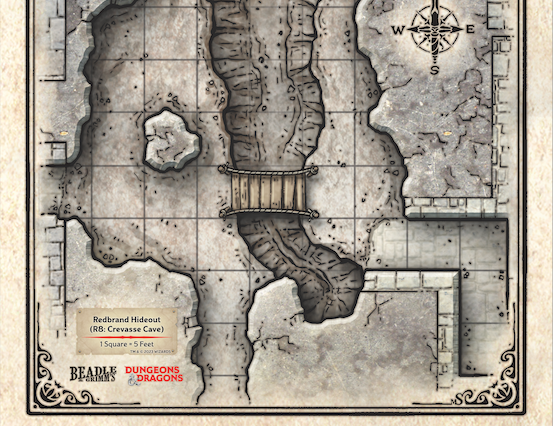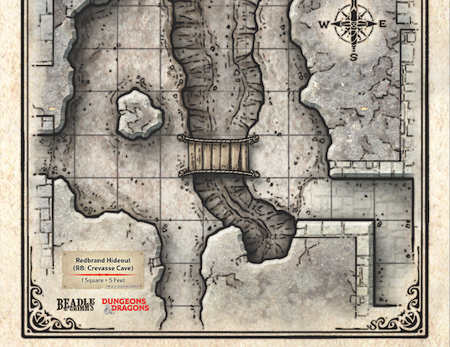
In this session the party discovered and delved into The Redbrand Hideout, which is a really fun area. Remember, my party has six characters in it, so I have to make some adjustments in order to challenge my party, and I did that here. The Glasstaff’s quasit familiar warned him that the party was approaching, so Albreck slipped out his secret exit to collect all his forces and lay an ambush for the party in the Crevasse Cave. It was an epic battle and likely much more memorable than if he had been attacked while alone.
Activities Mix
Different players often prefer different activities as part of playing D&D. Some prefer more combat and optimizing, some love roleplaying and socializing, and others dig exploring, investigating, or storytelling. This is never going to be all or nothing though, i.e. “Rob wants combat and Luis wants roleplaying.” It’s almost always going to be measured in degrees. Most players are going to want a good mix of most game elements, with some leaning toward one type of element more than others.
Best practice is to design your sessions, or series of sessions, to have a healthy mix of all of the elements. If you think your session is going to be super heavy in exploring and investigation, mix in a fight. If the next couple of sessions are going to be heavy in dungeon crawl and combat, be sure to work in roleplaying and storytelling beats.
Don’t get caught in the trap of leaning too much into one element consistently (unless you know for SURE that your players really want to load up on that one element). I’ve been in games in my past that are 10% storytelling and 90% combat, with very little exploring and role-playing. For me, that might work for a session or two, but over the course of a long campaign, it gets tedious. I’ve also experienced (and even DMed!) investigation games that were entirely consumed with problem-solving, and you can see the players getting antsy before your eyes!
One tricky mix that I’m currently dealing with is I have some players who love Acting and Investigating and other players that greatly resist those elements. It’s tough to balance. The best you can do is to try to keep the lines of communication open and encourage the players to be patient during the parts of the game that they don’t lean into. Keep mixing it up. Try to give something to everyone, but if you can’t, you can’t. Do beat yourself up over it.
Ability Checks
I’ll keep this short. Don’t have your players make an ability check for mundane things. Things that don’t have consequences.
Player: I’ll look to see if someone is following us.
DM: Make a Perception check.
Player: Natural 20!
DM: You don’t see anyone.
DMs often overuse Perception. Players often overuse Insight.
DM: The bartender leans in and asks if she can get you a drink.
Player 1: Insight check! Is she hiding something?
DM: You don’t think so. She just seems to be taking your order.
Player 2: I’ll do Insight too!
Don’t do it. Just don’t.
DM Tools:
When The Glasstaff slipped away and planned his attack on the PCs, he could have attacked almost anywhere in the Redbrand Hideout.
I knew I had a cool battle map of area R8, the Crevasse Cave, so that’s where they attacked.
I’m not above nudging the story to utilize cool props/accessories. I'm not above it, I tell you.
Some fun in-world handouts were found by the players in this session (Spider's letter anyone?). I love handouts and clues that pay off down the road in a long-running adventure, sometimes way down the road. It gives the adventure an epic ‘everything is connected’ quality that I love about running published D&D adventures.
Next: Session 6 (unfinished business)
Activities Mix
Different players often prefer different activities as part of playing D&D. Some prefer more combat and optimizing, some love roleplaying and socializing, and others dig exploring, investigating, or storytelling. This is never going to be all or nothing though, i.e. “Rob wants combat and Luis wants roleplaying.” It’s almost always going to be measured in degrees. Most players are going to want a good mix of most game elements, with some leaning toward one type of element more than others.
Best practice is to design your sessions, or series of sessions, to have a healthy mix of all of the elements. If you think your session is going to be super heavy in exploring and investigation, mix in a fight. If the next couple of sessions are going to be heavy in dungeon crawl and combat, be sure to work in roleplaying and storytelling beats.
Don’t get caught in the trap of leaning too much into one element consistently (unless you know for SURE that your players really want to load up on that one element). I’ve been in games in my past that are 10% storytelling and 90% combat, with very little exploring and role-playing. For me, that might work for a session or two, but over the course of a long campaign, it gets tedious. I’ve also experienced (and even DMed!) investigation games that were entirely consumed with problem-solving, and you can see the players getting antsy before your eyes!
One tricky mix that I’m currently dealing with is I have some players who love Acting and Investigating and other players that greatly resist those elements. It’s tough to balance. The best you can do is to try to keep the lines of communication open and encourage the players to be patient during the parts of the game that they don’t lean into. Keep mixing it up. Try to give something to everyone, but if you can’t, you can’t. Do beat yourself up over it.
Ability Checks
I’ll keep this short. Don’t have your players make an ability check for mundane things. Things that don’t have consequences.
Player: I’ll look to see if someone is following us.
DM: Make a Perception check.
Player: Natural 20!
DM: You don’t see anyone.
DMs often overuse Perception. Players often overuse Insight.
DM: The bartender leans in and asks if she can get you a drink.
Player 1: Insight check! Is she hiding something?
DM: You don’t think so. She just seems to be taking your order.
Player 2: I’ll do Insight too!
Don’t do it. Just don’t.
DM Tools:
When The Glasstaff slipped away and planned his attack on the PCs, he could have attacked almost anywhere in the Redbrand Hideout.
I knew I had a cool battle map of area R8, the Crevasse Cave, so that’s where they attacked.
I’m not above nudging the story to utilize cool props/accessories. I'm not above it, I tell you.
Some fun in-world handouts were found by the players in this session (Spider's letter anyone?). I love handouts and clues that pay off down the road in a long-running adventure, sometimes way down the road. It gives the adventure an epic ‘everything is connected’ quality that I love about running published D&D adventures.
Next: Session 6 (unfinished business)


0 comments